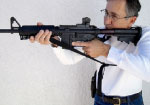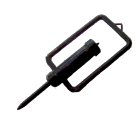By Charles H. Budde, FBINAA Session 187
Law enforcement and military personnel seem to have many things in common, among them similarities in traditions and a fondness for collecting memorabilia related to their  professions. The Challenge Coin represents one such item.
professions. The Challenge Coin represents one such item.
During World War One, American volunteers from all over the country filled the newly formed flying squadrons. Some were wealthy scions who attended such colleges as Yale and Harvard and dropped out in mid-semester to join the military. In one squadron, a wealthy lieutenant ordered for every member of his squadron medallions struck in solid bronze with his squadron's emblem. He hung the medallion in a small leather sack around his neck.
A short time later, enemy ground fire severely damaged the lieutenant's aircraft, forcing him to land behind enemy lines. A German patrol immediately captured him. The Germans took him to a small French village near the front. To discourage escape, they took his personal identification but left the sack around his neck. During a bombardment of the village that same night, the lieutenant donned civilian clothes and escaped.
Dodging German patrols, he reached the front line and crossed into no man's land, eventually reaching a French outpost. Not recognizing the pilot's American accent, the French thought he was a saboteur and were ready to execute him (saboteurs, often masquerading as civilians, plagued the French forces in this area). Thinking quickly, he remembered the sack around his neck and the medallion inside it. He showed the medallion to his would-be executioners, who recognized the squadron insignia and delayed the execution long enough to establish his identity. Instead of executing him, they gave him a bottle of wine.
When he returned to his squadron and related his story, everyone began to carry their medallions with them at all times, and the practice of challenging was born. The challenge worked this way: A challenger would ask to see the medallion, which became known, as a coin. If the one being challenged could not produce his coin, he had to purchase a drink of choice for the challenger. If the one challenged produced the coin, the challenger bought the drink. This became a tradition within the squadron and continued through the duration of the war. It continued for many years after, while the surviving members of the squadron were still living, and it remains a tradition for others in the military and law enforcement today.
which became known, as a coin. If the one being challenged could not produce his coin, he had to purchase a drink of choice for the challenger. If the one challenged produced the coin, the challenger bought the drink. This became a tradition within the squadron and continued through the duration of the war. It continued for many years after, while the surviving members of the squadron were still living, and it remains a tradition for others in the military and law enforcement today.





